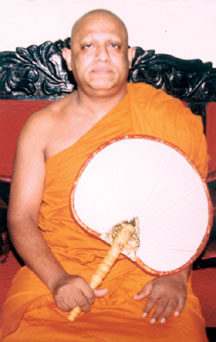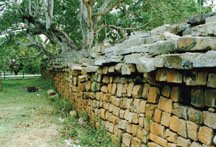|
observer |
|
|
|
|
|
OTHER LINKS |

|

|

|
|
|
|
The original bodhi tree, which was in Bodhgaya, India, is believed to have died, not even a branch has survived. What is now found at this site is said to be a bo tree which had been planted much later. So, now you realise just how important the Jayasri Maha Bodhi in Anuradhapura is.
This tree was planted in the Mahamevuna Uyana on the Unduvap Poya day of 234 BC (236 Buddhist Years). Therefore, the tree has a history going back over 2,240 years. Thus, we can safely assume that this is the oldest historically documented tree in the world.
The Sri Maha Bodhi is not only the oldest tree in the world, but it's also the tree planted in the biggest flower pot in the world, said botanist Bhathiya Sumithrarachchi.
The 'chief doctor' of the Sri Maha Bodhi, he said that this tree has many lateral roots and follicle roots instead of a main root. That is because it has been planted from the southern branch of the tree. No other bodhi in the world has been planted through this method. All other bo trees in sacred premises throughout the world have sprung up from seeds and saplings. Most of our temples have bo trees which have sprung up from the fruit of the Sri Maha Bodhi and they have a main root.
|
|
The pot containing the tree had been built by King Devanampiya Tissa. Twenty one feet tall, 57 feet wide and 71 feet long, it has been built as a mound of soil encircled by rocks. The bo tree is planted in its first layer.
According to Ruwanveliseya Viharadhipathi Ven. Pallegama Hemarathana Thera, large rock splinters had covered the bodhi when it was initially planted. "These splinters were discovered recently, when the soil around the tree was removed to treat the tree," he said.
"From the old days to now, Sri Lankans, especially those in the Rajarata area, have considered the Sri Maha Bodhi, not only as having religious and cultural significance, but also as blessing them and coming to their aid in bad times. Other customs which are observed to this very day are the 'Aluth Sahal Mangalya', where the first paddy harvest is offered to the bodhi, and bathing the tree with the first water whenever a new well is dug in the area," the Thera said.
From the very early days, the task of taking care of the Jayasri Maha Bodhi had been designated to certain people. Emperor Asoka of India had sent people from 18 clans specifically for this purpose, when he sent the bo tree to Sri Lanka. To this day, their descendants had been carrying out these tasks in an honourable way.
They had even been bestowed with villages from the kings of those days. The Thera said: "the Rajarata civilization went into ruin during the middle of the 13th century. Jungles spread over the sacred places in the area. But the people of these designated clans had settled beside tanks, and continued caring for the bodhi even at great risk to their lives".
|
|
"Sometimes, elephants had come to eat the bo leaves. These people had lit up bonfires around the tree to drive them away, and had stayed up overnight. Nearby villagers had provided them with the necessary wood to light up the fires. Even today, people come and offer piles of wood to the bo tree on Nikini Poya Day, in a ritual known as the 'Daramiti Perahera', to symbolise this tradition".
"There are many tasks assigned to these people who have been caring for the bo tree. One of their main tasks is to drive away animals like monkeys and crows who harm the bodhi. Discarding old flowers, keeping the bodhi premises clean and providing protection are some of the other tasks."
The huge rock wall, which surrounds the bodhi to this day, was built by King Kirthi Sri Rajasinghe of Kandy to protect the tree from animals like elephants and bulls. This wall is 12 feet high, 270 feet wide, 360 feet long and seven feet thick. It also contains 750 windows to hold lamps. Sumithrarachchi, who treats the bo tree, said one sapling of the tree had died in February 1983. "After this, we conducted experiments on the soil, and realised that the tree grows best in reddish brown soil.
So, in 1985, we started gradually removing the sand around the tree and replacing it with soil. Also, to prevent any harm caused by the roots of the surrounding bo trees, we put up a six inch thick concrete, 4 1/2 feet deep into the ground," he said.
There are two types of bo trees in Sri Lanka, but both types are not sacred. The botanical name for the sacred bo tree is Ficus religiosa. The other type, which is referred to as 'kaka bo' and 'kavudu bo', is botanically known as Ficus arnottiana.
The trunk of the sacred bo tree is white in colour, while in the other tree, these parts are red. Although the bo tree belongs to the banyan family, the sacred bo tree doesn't have roots hanging to the ground like the kaka bo tree.
The kaka bo, which is seen in the jungles of the dry zone and other parts of the country, is shorter than the sacred bo trees. A unique factor is that sacred bo trees have a neater system of branching.
Atamasthanadhipathi Ven. Pallegama Siri Nivasa Thera said the Sangha had worked tirelessly to protect the bodhi. "We recently completed the second golden fence of the bodhi. A perahera pathway was built alongside it. Now, a dharmasala and vahalkada are being built. Many special arrangements have been planned for its protection. We are getting the full cooperation of the armed forces in this regard. Recently, we established 10 gold-plated supporting pillars for the bodhi. Many offered their support for these projects," the Thera said.
On July 30, 1929, a mentally imbalanced man chopped a branch off the tree. The two protective fences were built and the entrance to the uda maluwa (upper compound) was restricted after this.
Although the premises came under a terrorist attack on May 14, 1985, no damage was caused to the bodhi. Now, it's again time that all efforts are made to protect the Jayasri Maha Bodhi, which is a national as well as an international treasure, the Thera said.










